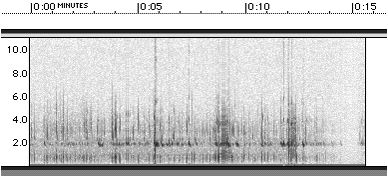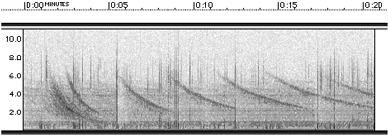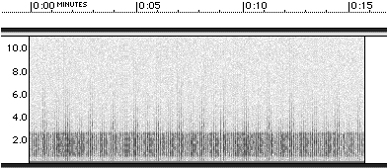|
Sferics, short for "atmospherics", are the impulsive signals emitted by lightning. The frequency range is from a few hertz to millions of hertz. The part of this range that we can hear (the audio range) has frequencies up to about 15 thousand hertz (15 kHz). The spectrograms of sferics are characterized by vertical lines on the frequency-time graph indicating the simultaneous arrival of all of the audio frequencies. The sound of sferics consists of sharp crackling noises like twigs snapping or sizzling noises like bacon frying. Sferics are caused by lightning strokes within a couple of thousand kilometers of the receiver. The VLF radio signal is ducted to the receiver between the surface of the earth and layers in the ionosphere which reflect radio waves. This path is called the earth-ionosphere waveguide.
Note: We can't really "hear" radio waves. The audio range refers to the radio waves that, when fed directly into a speaker, can be heard.
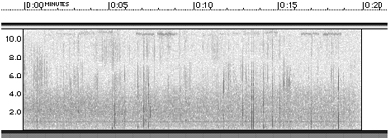

Dense Sferics
Tweeks result when sferics are ducted in the earth-ionosphere waveguide distances much greater than a couple of thousand kilometers. The distance can be as great as halfway around the earth (20,000 kilometers). When ducted over large distances, the VLF radio waves undergo a process called dispersion - that is the higher frequencies travel slightly faster than the lower frequencies. This is especially true of the frequencies between 3 and 2 kilohertz. Tweeks sound much different than sferics. Instead of the sharp crackling sound, tweeks have a quick musical sound somewhat like the ricochet sound bullets make (at least in the movies). The spectrogram of a tweek shows a vertical line at the higher frequencies with a curved section (called the "hook") appearing at a frequency of about 2 kilohertz.

Tweeks
Under the right conditions, the VLF signal travels out away from earth and returns by traveling along a magnetic field line. During this long path, dispersion is much greater than with tweeks. While tweeks might disperse a few hundred kilohertz over a few thousandths of a second, whistlers show a dispersion of a second or more over several thousand kilohertz. The sound of a whistler is a musical descending tone that lasts for a second or more. On the spectrogram, whistlers appear as long sweeping arcs showing the sequential arrival of the frequencies. It is important to remember that all of the frequencies start out at the same time (a sferic), but the path taken by a whistler is so long that the dispersion of the frequencies is quite pronounced.
Pure Note Whistler
A pure note whistler has traveled along a signal magnetic field line. It is heard as a clear whistling sound and appears on the spectrogram as a strong single curve. The following shows two whistlers: one at :09 seconds and a stronger one at :13 seconds. The horizontal dashes are OMEGA signals. Several other faint whislters are audible in the sound sample.
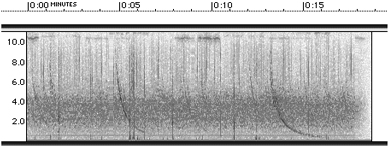 Diffuse Whistlers
Diffuse whistlers have traveled along a set of magnetic field lines that are not all of the same length. The sound is "breathy" or "swooshy". The spectrogram shows the whistler as a broad region rather than a narrow curved line.
Two-Hop Whistlers
Two-hop whistlers originate near the receiver site. The signal that travels along the magnetic field line bounces off the ionosphere in the other magnetic hemisphere and returns to be heard as a whistler near where the original lightning stroke occurred. Two-hop whistlers can be identified by the presence of a strong "local" sferic between one and two seconds before the whistler is heard. Remember, local lightning is within about 2000 kilometers of the observing site.
Whistler Echo Train
Echo trains result when the radio wave bounces back and forth between magnetic conjugate points. Each time the signal bounces off the ionosphere, some of the energy leaks down in the lower atmosphere and is heard as a whistler. All of the whistlers in the train are the result of a single lightning stroke. Successive "hops" of the whistler are seen with increasing dispersion time as the distance traveled grows with each bounce.
Chorus
Occasionally, especially in the quiet times of the morning, a chorus can be heard. Chorus sounds like many birds calling in turn. Chorus seems to be the result of many brief, short-path whistler-like emissions occurring at almost the same time.
Triggered Emissions
Sometimes you will hear rising tones that seem to be caused by other emissions. These are called triggered emissions.
The power grid radiates VLF radio waves at frequencies of 60 hertz and the harmonic multiples of that number. The sound is a background hum that is stronger the closer the receiver is to the lines and also stronger if the line voltage is higher. On the spectrogram, 60 Hz hum appears as a line or series of lines running horizontally near the bottom of the spectrogram.
LORAN navigation signals can be heard in the VLF range. The sound is that of a rapid clicking. On the spectrogram, a series of closely spaced dots appear in evenly spaced horizontal rows.
The three Russian ALPHA navigation transmitters each transmit a distinct set of tones that repeat. The frequency of the transmissions is between 13 kHz and 15 kHz, but sometimes they are heard at lower frequencies. On the spectrogram, ALPHA signals appear as a series of horizontal dashes.
OMEGA was a navigation signal operated by the US Coast Guard (in the United States) and other countries around the world. In the frequency range above 10 kilohertz, the signal could be heard as a repeating series of tones. On the spectrogram, OMEGA show up as a series of horizontal dashes of about one-second duration. Each of the seven OMEGA stations transmitted a unique pattern of four tones that repeated every ten seconds. OMEGA ceased operation in September 1997, done in by the advent of global positioning system (GPS) technology. Those of us who have studied VLF miss OMEGA signals.
In the spring of 1992, INSPIRE participated in the SEPAC (Space Experiments with Particle Accelerators) experiment carried on board the Shuttle Atlantis as part of the ATLAS 1 mission (STS-45). SEPAC consisted of an electron gun mounted on a pallet in the payload bay which could shoot a modulated beam of electrons into space. INSPIRE attempted to record the resulting VLF waves created by turning the electron gun off and on at various frequencies. The sound files are simulated examples of the expected SEPAC radio signals. During the missions the signals were not detected on the surface of the earth although they were detected by a receiver on Atlantis. It was tentatively determined that the power output of the SEPAC instrument may not have been sufficient to be detected on earth.
|






